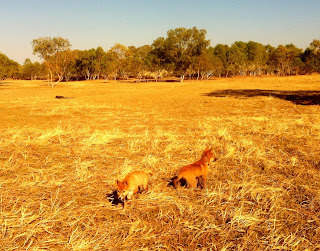DINGO FACTS
Often when we are out with the dingoes we see people stop and stare at them and we know what is running through their minds, “are they dingoes?” Those that are more inquisitive will actually ask what they are. When we inform them that they are dingo pups the people are very surprised.
Then the questions flow: “Are you allowed to keep them?” “Are they vicious?” “What are they like to live with?” And so it goes.
Here are a few quick dingo facts:
· Dingoes cannot bark - but they can howl.
- Dingoes have unique wrists in the canine world, capable of rotation. This enables dingoes to use their paws like hands and turn door knobs. Their ability to go where other dogs can't means dingoes can cause more problems for humans than other wild members of the dog family can.
- A dingo can turn its head through almost 180 degrees in each direction.
- Dingoes have permanently erect ears.
- The plural of dingo is dingoes, not dingos.
- Male dingoes are larger than females. Males weigh 26 to 43 pounds (12 to 20 kg) and females weigh 21 to 35 pounds.
- Most Australian dingoes are ginger-coloured or sandy coloured with white chests. There are also dark coloured dingoes.
- Wild dingoes can live for up to ten years but usually live for more like five or six years.
- Dingoes cared for by people can live up to 15 years or more.
- Domestication of dingoes has been difficult. Dingoes are intelligent animals. They are more independent and harder to train than other dogs.
- Dingoes have larger canine teeth than domestic dogs.
- Wild Australian dingoes kill and eat prey ranging in size from small lizards, birds and rodents up to sheep and kangaroos. They will also scavenge carrion.
- The days of the pure dingo may be numbered. Dingoes are increasingly mating with feral domestic dogs. Some of the genetically purest dingoes live on Fraser Island in Queensland.
- Dingoes breed once a year.
- Australian dingoes mate in autumn.
- Dingoes' gestation period is two months.
- Dingoes produce one litter of pups each year.
- Dingo litter sizes range between one and ten pups. The average number of pups born is five or six.
- The dominant female dingo kills any pups born to other females in a dingo pack.
- Pack members help care for the pups of the dominant dingo pair.
- At around 8 weeks old, pups are weaned onto solid food, often consisting of regurgitated meat.
The important thing to remember is that dingoes are not dogs, they are a separate species. The dingo (Canis lupus dingo) probably descended from the Indian Wolf (Canis lupus pallipes). Studies of dingo skeletons suggest they are very similar to Indian pariah dogs and wolves. Australian dingo skulls are between those of dogs and wolves.
Dingoes appear to be somewhere between wolves and dogs. This makes it possible that dingoes are the descendants of one of man's early attempts to domesticate wolves.
Dingoes appear to be somewhere between wolves and dogs. This makes it possible that dingoes are the descendants of one of man's early attempts to domesticate wolves.




0 Comments:
Post a Comment
Subscribe to Post Comments [Atom]
<< Home